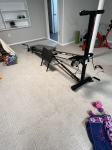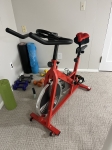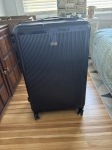Heat when power is out - battery backup
Do you have to kill the circuit or the emergency switch to boiler so when power comes back on its not overloaded or is there some auto feature that does that ?
georgieboy said:
Do you have to kill the circuit or the emergency switch to boiler so when power comes back on its not overloaded or is there some auto feature that does that ?
The nice thing about the way this electrician did it was to take the hard wire connection between the house electric and furnace and separate it into a 3-pronged plug and standard receptacle. When the plug is in that receptacle, the furnace gets electricity from the house. When power goes out there is no automatic switchover. I unplug it from the house receptacle, and plug it into the inverter/battery setup (and do the reverse when power comes back on).
I did this during Sandy and helped a couple of neighbors do the same, except that none were nicely hardwired like yours.
I used a 60W inverter that I had lying around, but could probably get by with a smaller output model to extend the battery life. I would suspect a large inverter would kill the battery much quicker. The inverter in your photo looks pretty large.
I had used the battery from one of my cars since it was all I had - however, you have the right idea with a deep cycle battery. Not having a generator, I reinstalled and charged it in the car during daylight hours so that it would have enough juice to last overnight.
Also, did someone tell you that you should never keep a battery on the floor? I always heard that growing up, but think it's an old wives (mechanic's) tale.
I was worried about the floor because of the risk of water - esp during a power outage, so it is on a concrete block, about 5" off the floor
That looks like a nice setup.
One thing you I urge you to address though: pretty much all batteries, whether dry or flooded, gel, or otherwise, including marine batteries, can have have hydrogen outgassing as a result of hydrolysis during charge. Sealed marine batteries are less likely to be a problem, but can still outgas too if charged rapidly.
Since hydrogen gas is highly flammable, I would make sure you have some way of venting any hydrogen to the outside when it's charging. You don't want that near the pilot flame of your boiler. It could be as simple as an enclosure with a small fan and duct/hose to the outside.
Also, and I'm sorry to nitpick: please please cover those terminals. If some conductor nearby (a metal bucket, piece of scrap pipe, bike, shovel, a wrench, screwdriver) accidentally shorts it out, your battery could explode or cause a fire. Those batteries can literally deliver hundreds of amps (which at 12V is enough to be a real problem). Look for a "battery box" that exist for that purpose.
Not sure, but I thought code required things like boilers to be hard wired? Did the town actually inspect it? Agree that the battery should be in a box and would add that the inverter should be hard wired to battery with the appropriate DC fuse on the positive terminal. Don't want to electrocute anyone or start a fire. A short across the battery terminal would be disastrous. Yes, indoor battery has to be sealed type. Simple and effective setup.
I am a little confused - do you use a plug with two male ends to deliver the power? One end plugged into your house or battery and the other end into the furnace?
yea, using plugs isn't code compliant. I wired in a plug during Sandy to keep things running, hard wired back again afterwards.
Excellent idea but the "electrician" who did this is a hack. Sorry, but this is unsafe.
well, we have a permit and will get it inspected soon. I'll let you know if the town says it is non-compliant.
Why does the code say that electrical from boiler has to be hard wired? And does it also apply to low water cut off and damper control? They obviously need power for the while system to work.
Wow, thank you for this. I was out 16 days during Sandy and was terrified when we had this last winter storm. I was actually going to break down and get one of the stand-by generators as I don't see myself running cords and wires around the house to hook up to a portable, nor do I want to store lots of gasoline. (My neighbor stored some and we recently discovered someone took the whole can and stashed it in the woods on my property!)
I'm going to call an electrician and suggest this option.
Thanks again.
I built one of these with @tourn's help after Irene. It had an additional feature of a solar input to charge the battery during extended outages. We had a transfer switch wired into our panel for the battery input, so all up to code. Never needed to use it as we never lost power again (even during Sandy). We're moving so I'm disassembling the system. I have 4 70AH 12v batteries up on the Swap for cheap, if anyone is interested.
Morganna said:
Wow, thank you for this. I was out 16 days during Sandy and was terrified when we had this last winter storm. I was actually going to break down and get one of the stand-by generators as I don't see myself running cords and wires around the house to hook up to a portable, nor do I want to store lots of gasoline. (My neighbor stored some and we recently discovered someone took the whole can and stashed it in the woods on my property!)
I'm going to call an electrician and suggest this option.
Thanks again.
Let me know if you want the phone # of the one we used (A-1). They say they have done a number of these and seemed very professional.
what he should have done is to install a single circuit transfer switch at the boiler, instead of just a plug.... that way it is still hardwired and you could use an extension cord to plug in during a power outage
terminator3 said:
what he should have done is to install a single circuit transfer switch at the boiler, instead of just a plug.... that way it is still hardwired and you could use an extension cord to plug in during a power outage
It's just an outlet though. How is there any back feed risk?
there should be no backfeed risk. If plugs are not code compliant then the transfer switch would make it code compliant
I did the same thing during the last major outage. I use a combination Black and Decker jump-start/compressor unit which has a built in inverter to supply 120AC. I looked into it pretty carefully, and I agree that a dedicated transfer switch is the right way to do it. This is all you need:
http://www.amazon.com/gp/product/B000HRWG8U
terminator3 said:
what he should have done is to install a single circuit transfer switch at the boiler, instead of just a plug.... that way it is still hardwired and you could use an extension cord to plug in during a power outage
I made one of these also with the inverter and a battery. I also want to add that pedal charger thing to keep the battery going.
RichEW said:
georgieboy said:
Do you have to kill the circuit or the emergency switch to boiler so when power comes back on its not overloaded or is there some auto feature that does that ?
The nice thing about the way this electrician did it was to take the hard wire connection between the house electric and furnace and separate it into a 3-pronged plug and standard receptacle. When the plug is in that receptacle, the furnace gets electricity from the house. When power goes out there is no automatic switchover. I unplug it from the house receptacle, and plug it into the inverter/battery setup (and do the reverse when power comes back on).
If the male end of the plug/outlet (beneath the shut-off switch) has power then you are at risk of an electric shock. Consequently, I doubt the set-up will pass inspection
While I am impressed by the ingenuity and know-how of the do it yourselfers here, it makes me nervous that people are inadvertently overlooking safety precautions as they go, tinkering with electricity and gas that could affect lives. I don't think this is what the inspectors are fond of, although it will be interesting to hear which ones pass.
How would the male end have power? What am I missing here? How is this any different from powering your refrigerator with a battery? (Aside from the difference in power requirements)
I may not have been clear. The power from the house is in the receptacle. The 3-pronged plug from the boiler goes into the receptacle. In an outage it is removed and plugged into the inverter. The electrician said he has done it before and passed inspection (we got a permit). If it doesn't pass inspection I'll change it.
One of the requirements of any setup is that the circuit needs to be isolated from the line supply. In the event that workers are fixing a downed line, they need to know that there is no chance that any of the lines are "hot" because they are being back-fed by something in the house. That's why transfer panels have a clear differentiation in the circuits/supply side. They are either connected to the line (power company) or to your generator (but not both).
Now, a 12V SLA battery isn't going to kill anyone, but it's tempting to use the setup with a generator which can supply 25 Amps on a circuit.
Another quick aside - the amount of current required to start a boiler is minimal. You could easily get away with a 12V SLA or LiFePo4 battery, which is what is used in UPSes.
RichEW said:
I may not have been clear. The power from the house is in the receptacle. The 3-pronged plug from the boiler goes into the receptacle. In an outage it is removed and plugged into the inverter. The electrician said he has done it before and passed inspection (we got a permit). If it doesn't pass inspection I'll change it.
RichEW said:
I may not have been clear. The power from the house is in the receptacle. The 3-pronged plug from the boiler goes into the receptacle. In an outage it is removed and plugged into the inverter. The electrician said he has done it before and passed inspection (we got a permit). If it doesn't pass inspection I'll change it.
Hope it works. Like the ingenuity and price point. Many of us would have benefited from this in the aftermath of Sandy.
There was a whole thread about this in the aftermath of Sandy. There were some local electricians doing this exact modification and lots of people talked about it here.
Catch22, the way the setup is done the boiler is completed powered via a regular 15 amp receptacle. There's a power cord that goes from the boiler circuitry to the receptacle. In the event of a power outage you unplug the boiler and plug it into the inverter, and there is no physical connection between that electrical circuit and the house electric system. As Rich was saying it's like unplugging any major appliance and plugging it into a different power source.
One thing I like about this setup is that the receptacle is mounted on the metal jacket of the boiler, so the boiler stays grounded no mater what.
For Sale
-
REVO luggage $100
More info
Free Items
Rentals
-
Huge Brand New construction Apartment in 2 family home with 4 bedrooms 3 bathrooms
4 Bd | 3Full Ba
$4,500

























This note for those of you concerned about losing heat during a power outage (this wasn't a problem in the "old days" when boilers had pilot lights. Now. with electronic ignitions non power = no heat).
Yesterday I added a battery backup that should provide enough electricity to allow my steam boiler to work during a power outage. The idea came from a friend who is an electrical engineer - he did his own wiring. I am not so skilled, and wanted a licensed electrician - just in case my home insurance company ever asked. The whole job - a marine 12v battery, inverter, and battery charger, plus electrician's time cost about $500. Add another $95 for the town permit. This electrician (A-1) set it up as a duplex outlet on the furnace with a plug coming from the main electric circuit for normal operation (see photos). In an outage, just take the same cord and plug it into the inverter. You could also use a UPS or generator if you prefer.